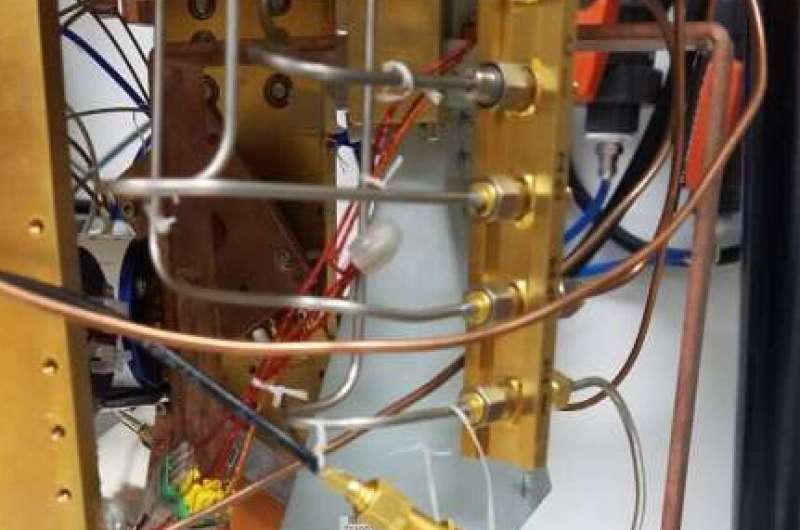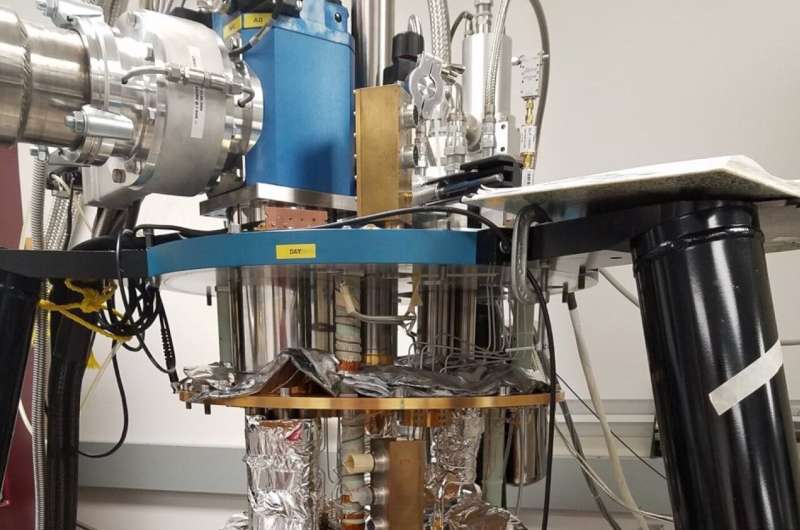July 13, 2023 feature
This article has been reviewed according to Science X's editorial process and policies. Editors have highlighted the following attributes while ensuring the content's credibility:
fact-checked
peer-reviewed publication
trusted source
proofread
Study sets new constraints on the kinetic mixing of hidden photon dark matter

As dark matter is comprised of particles that do not absorb, emit or reflect light, it cannot be observed directly with the methods used to observe conventional matter. In recent years, astrophysicists worldwide have thus been devising methods that could help to detect this elusive type of matter.
Researchers at California Institute of Technology recently set new direct detection constraints on hidden or dark photon dark matter, a dark matter candidate hypothesized to have a weak interaction with ordinary photons (light). Their paper, published in Physical Review Letters, introduces a new approach to search for hidden photons.
"The sensitivity of a hidden photon dark matter experiment depends on the strength of the dark matter signal compared to the smallest signal you can detect," Nikita Klimovich, one of the researchers who carried out the study, told Phys.org. "For hidden photon searches, the amplitude of the dark matter signal scales with the area of the metal dish used, while the minimal detectable signal level is largely determined by the noise level of the amplifiers used to read out the antenna. "
The recent work by Klimovich and his colleagues builds on past searches for hidden dark matter, such as the SHUKET experiment. The SHUKET experiment is an ambitious research effort aimed at detecting ultra-light dark matter using an electromagnetic telescope.
"Previous searches that inspired this work, like the SHUKET experiment, generally aimed to maximize the signal strength through having a very large dish while using the best commercially available low-noise amplifiers they had access to," Klimovich explained.
"Karthik Ramanathan realized that we had the potential to take the opposite approach."
"Using quantum-limited amplifiers that I was developing and performing the entire experiment at milliKelvin temperatures, we could significantly reduce the minimal signal levels we could detect compared to other experiments using off-the-shelf low noise (but not quantum-limited noise) technology,"
The team's proposed approach to search for hidden photons has a key disadvantage. Specifically, the little available space inside a cryostat would significantly limit the size of the dish they could use, resulting in a significantly lower raw signal than that detected by other experiments, including SHUKET.
Nonetheless, Klimovich, Ramanathan and their colleagues hoped that the increased sensitivity of the measurement collected using their method would compensate for this limitation, allowing them to set new limits on the detection of dark photons. In their experiments, they essentially examined the signal emitted by a spherical metallic dish, comparing it to that of a so-called reference load.
"If a hidden photon existed with a mass corresponding to the frequency range we were sensitive to, we should see a small excess lump of power coming from the dish compared to the reference," Klimovich said. "Because we saw no such signal, we could set a new upper limit on the coupling of such a hidden photon particle to the electromagnetic field based on the smallest signal level we would have been able to detect."

Using their proposed approach, the researchers were able to introduce new stringent constraints on the direct detection of hidden photons. While they so far did not detect this dark matter candidate, they hope that their approach will be used to carry out further searches, ultimately contributing to its detection.
"Aside from the new limits set on detection, we have demonstrated a very accessible approach for hidden photon experiments in the future," Klimovich added.
"A QUALIPHIDE-type dark matter search would be a cheap and relatively simple experiment for most research groups that have access to quantum-limited amplifiers. We hope to use a similar methodology to both search for hidden-photons at higher frequencies (where the current constraints on hidden-photon coupling are weaker) and enhance the setup to enable the detection of other types of dark matter such as axions."
More information: K. Ramanathan et al, Wideband Direct Detection Constraints on Hidden Photon Dark Matter with the QUALIPHIDE Experiment, Physical Review Letters (2023). DOI: 10.1103/PhysRevLett.130.231001
Journal information: Physical Review Letters
© 2023 Science X Network





















